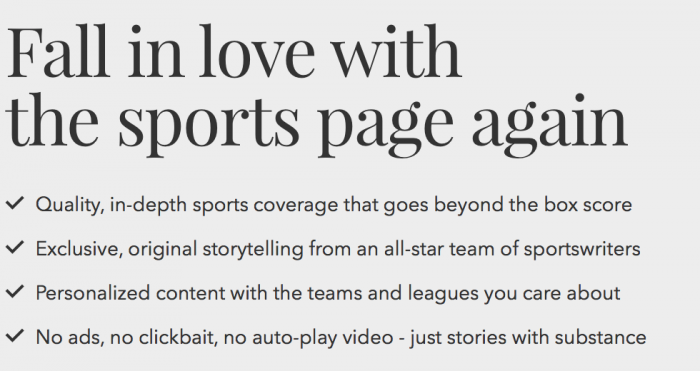
It’s the first thing when you go to The Athletic’s home page before you subscribe.
“Fall in love with the sports page all over again.”
That’s the central pitch The Athletic has made since it began in Chicago in 2016. It is a different kind of sports site. There are no ads, no auto play videos. You have to pay to read any story. “Quality, in-depth sports coverage that goes beyond the box score.”
Much of the popular and trade press coverage of The Athletic has revolved around its business model, and rightfully so. But implicit in its marketing slogans is a promise of sorts. If The Athletic styles itself as the sports news organization that is making readers “fall in love with the sports page again,” it stands to reason that they will be offering something different from the sports pages of current newspapers. If The Athletic is asking people to subscribe in a market saturated with free content, it stands to reason they are offering something different than most newspaper sports sections.
But what is that “something different?”
That’s what Dr. Galen Clavio] and I are attempting to address in our research on The Athletic. We presented findings of our exploratory study at the 11th Summit on Communication and Sport last week at Indiana University.
The purpose of our study was to examine the content practices of sports journalism subscription sites and to see how they compare with notions of traditional sports journalism as practiced by newspaper reporters and other online news sites. Basically, we are looking at what types of stories are writers at The Athletic publishing?
To do this, Galen and I studied 60 stories published on The Athletic’s three oldest U.S. sites — Chicago, Cleveland and Detroit — in March and April. With coding help from the brilliant Timothy Schoch and Morgan Gard, we looked at the types of stories published, the team covered, whether or not they had player quotes, coach quotes, and a dateline (the latter three items were our proxies for standard sports journalism practices).
Before we get to the results, a few caveats:
THIS IS A PILOT, EXPLANATORY STUDY.
That means this is our first pass through the data. It’s our chance to see what is there, give us an idea of the landscape and provide a basis for our future research. While we can come up with some ideas about what the data tell us, we’re not able to make any grand theoretical conclusions about The Athletic.
WE USED A CONVENIENCE SAMPLE.
Due to timing, and a few other logistical issues (primarily The Athletic’s not-easily-searchable archive), we were limited to stories published in March and April. This made data collection easier, but also could affect the results. March is not a time when there are as many games happening as other times of year (we’d have preferred the fall), and since The Athletic has a lot invested in baseball coverage, the time of year could have an impact on the types of stories we saw.
NO STATISTICAL SIGNIFICANCE.
You’ll not that all of the statistics presented here are descriptives. We ran a few crosstabs in an attempt to find relationships within the data, but nothing approached statistical significance. This may be because of the small sample size (60 stories is quite small), or it may be due to the questions we’re asking. At any rate, we’re sticking with our
None of these are meant to detract from our work, but instead contextualize what we found. This is the start of our research, not the end.
OUR FINDINGS:
The stories we coded were about a variety of subjects. There were five stories about the Indians, seven league-wide stories but no other team had more than three stories about it. This does suggest a variety of coverage on The Athletic. In all, 65 percent of the stories we coded had quotes from coaches, 58 percent had quotes from players, and 61 percent had some kind of dateline (indicating the reporter was on site). This suggests that The Athletic does follow traditional journalistic practices, but not overwhelmingly.

More than half of the stories in our sample were features and analysis. If you add in columns, then 70 percent of the stories we looked at in The Athletic were either column, features or analysis.
The most noteworthy item: There were only three game stories — 5 percent of the sample.
Again, this is an exploratory study. But the data suggests that The Athletic is providing a different content focus than traditional newspaper sports sections. It suggests that rather than replacing the traditional sports section, it is complementing it with features and analysis of games. In this respect, it may be useful to start thinking of The Athletic as less a replacement for daily sports pages and more as filling the void Sports Illustrated once dominated.
MOVING FORWARD
To continue our work, we would like to expand our sample to have more robust data. We also would like to compare The Athletic directly to newspaper sports sections in the same cities — both at the same time and from a historical context – to get a better comparison between the two.
One thing that came up during our research was the fact that there is no established theoretical typology of sports journalism. There is no set definition for what is a game story, a column, a notebook, an analysis piece (this last one is the most problematic, with an “I know it when I see it” definition). Going forward, one area of research would be to establish this typology and define what we mean by analysis in sports journalism.
Dr. Brian Moritz, also known as the Sports Media Guy, is an assistant professor at SUNY-Oswego. For more of Brian’s work, check out his website at https://www.sportsmediaguy.com/


